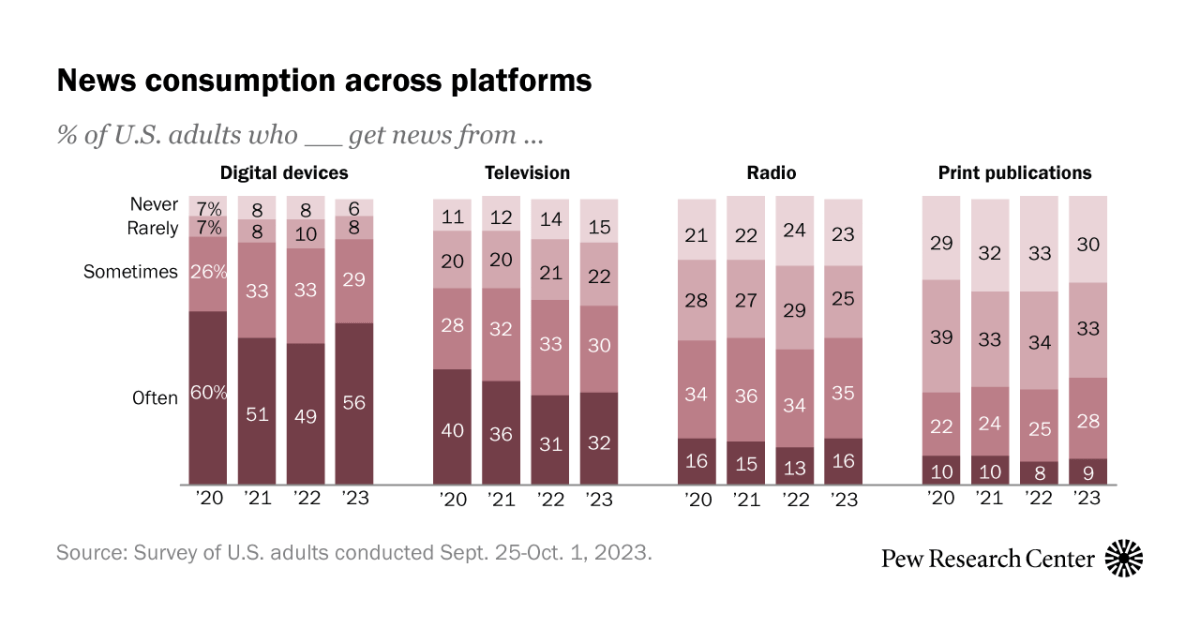Numbers, Facts and Trends Shaping Your World
Read our research on:
Full Topic List
Read Our Research On:
|
The transition of the news industry away from print, television and radio into digital spaces has caused huge disruptions in the traditional news industry, especially the print news industry. It is also reflected in the ways individual Americans say they are getting their news. Today, an overwhelming majority of Americans get news at least sometimes from digital devices. Explore the patterns and trends that shape the platforms Americans turn to for news below.
A large majority of U.S. adults (86%) say they often or sometimes get news from a smartphone, computer or tablet, including 56% who say they do so often. This is more than the 49% who said they often got news from digital devices in 2022 and the 51% of those who said the same in 2021. The portion that gets news from digital devices continues to outpace those who get news from television. The portion of Americans who often get news from television has stayed fairly consistent, at 31% in 2022 and 32% in 2023. Americans turn to radio and print publications for news far less frequently than to digital devices and television.
When asked which of these platforms they prefer to get news on, nearly six-in-ten Americans say they prefer a digital device (58%), more than say they prefer TV (27%). Even fewer Americans prefer radio (6%) or print (5%).
Though digital devices are by far the most common way Americans access their news, where they get that news on their devices is divided among a number of different pathways. Today, news websites, apps and search engines are the digital pathways most Americans get news from at least sometimes. Half of Americans at least sometimes get news from social media, and three-in-ten say the same of podcasts.
Among digital platforms, news websites or apps are also the most preferred source for news: A quarter of U.S. adults prefer to get their news this way, compared with 15% who prefer search, 12% who prefer social media and 6% who say they prefer podcasts.
News consumption across platforms varies by age, gender, race, ethnicity, educational attainment and political leaning. Americans ages 50 and older are more likely than younger adults to turn to and prefer television and print publications.
% of U.S. adults in each demographic group who get news at least sometimes from …
*Estimates for Asian adults are representative of English speakers only.
Note: White, Black and Asian adults include those who report being only one race and are not Hispanic; Hispanic adults are of any race.
Source: Survey of U.S. adults conducted Sept. 25-Oct. 1, 2023.
% of U.S. adults in each demographic group who get news at least sometimes from …
*Estimates for Asian adults are representative of English speakers only.
Note: White, Black and Asian adults include those who report being only one race and are not Hispanic; Hispanic adults are of any race.
Source: Survey of U.S. adults conducted Sept. 25-Oct. 1, 2023.
% of U.S. adults in each demographic group who say they prefer ___ for getting news
*Estimates for Asian adults are representative of English speakers only.
Note: White, Black and Asian adults include those who report being only one race and are not Hispanic; Hispanic adults are of any race.
Source: Survey of U.S. adults conducted Sept. 25-Oct. 1, 2023.
% of U.S. adults in each demographic group who say they prefer ___ for getting news
*Estimates for Asian adults are representative of English speakers only.
Note: White, Black and Asian adults include those who report being only one race and are not Hispanic; Hispanic adults are of any race.
Source: Survey of U.S. adults conducted Sept. 25-Oct. 1, 2023.
This fact sheet was compiled by Research Analyst Jacob Liedke and Research Associate Luxuan Wang.
Read the methodology and the topline.
Pew Research Center is a subsidiary of The Pew Charitable Trusts, its primary funder. This is the latest report in Pew Research Center’s ongoing investigation of the state of news, information and journalism in the digital age, a research program funded by The Pew Charitable Trusts, with generous support from the John S. and James L. Knight Foundation.
Follow these links for more in-depth analysis of news consumption:
Social Media and News Fact Sheet, Nov. 15, 2023
Americans are following the news less closely than they used to, Oct. 24, 2023
Black Americans’ Experiences With News, Sept. 26, 2023
For National Radio Day, key facts about radio listeners and the radio industry, Aug. 17, 2023
Podcasts as a Source of News and Information, April 18, 2023
The Role of Alternative Social Media in the News and Information Environment, Oct. 6, 2022
News on Twitter: Consumed by Most Users and Trusted by Many, Nov. 15, 2021
About four-in-ten Americans say social media is an important way of following COVID-19 vaccine news, Aug. 24, 2021
Large Majorities of Newsmax and OAN News Consumers Also Go to Fox News, March 23, 2021
More than eight-in-ten Americans get news from digital devices, Jan. 12, 2021
Measuring News Consumption in a Digital Era, Dec. 8, 2020
Many Americans Get News on YouTube, Where News Organizations and Independent Producers Thrive Side by Side, Sept. 28, 2020
Americans Who Mainly Get Their News on Social Media Are Less Engaged, Less Knowledgeable, July 30, 2020
Read all reports and short reads related to news platforms and sources.
123
456
1615 L St. NW, Suite 800
Washington, DC 20036
USA
(+1) 202-419-4300 | Main
(+1) 202-857-8562 | Fax
(+1) 202-419-4372 | Media Inquiries
ABOUT PEW RESEARCH CENTER Pew Research Center is a nonpartisan fact tank that informs the public about the issues, attitudes and trends shaping the world. It conducts public opinion polling, demographic research, media content analysis and other empirical social science research. Pew Research Center does not take policy positions. It is a subsidiary of The Pew Charitable Trusts.
Copyright 2024 Pew Research Center
